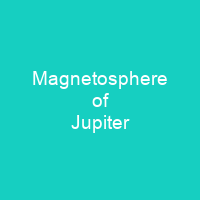The magnetosphere of Jupiter is the cavity created in the solar wind by the planet’s magnetic field. Extending up to seven million kilometers in the Sun’s direction and almost to the orbit of Saturn in the opposite direction. By volume it is the largest known continuous structure in the Solar System after the heliosphere. The action of the magnetosphere traps and accelerates particles, producing intense belts of radiation.
About Magnetosphere of Jupiter in brief

The magnetic field around Jupiter emanates from a number of different sources, including fluid circulation at the planets core, electrical currents in the plasma surrounding Jupiter and the currents flowing at the boundary of the Magnetosphere. This makes Jupiter’s field about 20 times stronger than Earth’s, and its magnetic moment ~20,000 times larger. Jupiter’s equatorial field strength is about 417.0 μT, which corresponds to a dipole magnetic moment of about 2.83 × 1020 T·m3. The planet’s internal field rotates at the same speed as the region below its atmosphere, with a period of 9 55 h55 m3 until 2019. It also has quadrupole, octupole and higher components, though they are less than one tenth as strong as the dipole component. As with Earth, Jupiter’s dipole is tilted roughly 10° from Jupiter’s axis of rotation; the tilt is similar to that of the Earth. Its north and south magnetic poles are at the ends of a single magnetic axis. However, on Jupiter the north pole is located in its northern hemisphere and the south pole lies in its southern hemisphere, opposite to the Earth, whose north pole lie in the southern hemisphere and south pole is in the northern hemisphere. The bulk of Jupiter’s magnetic fields is generated by an internal dynamo supported by the circulation of a conducting fluid in its outer core.
You want to know more about Magnetosphere of Jupiter?
This page is based on the article Magnetosphere of Jupiter published in Wikipedia (as of Nov. 22, 2020) and was automatically summarized using artificial intelligence.







